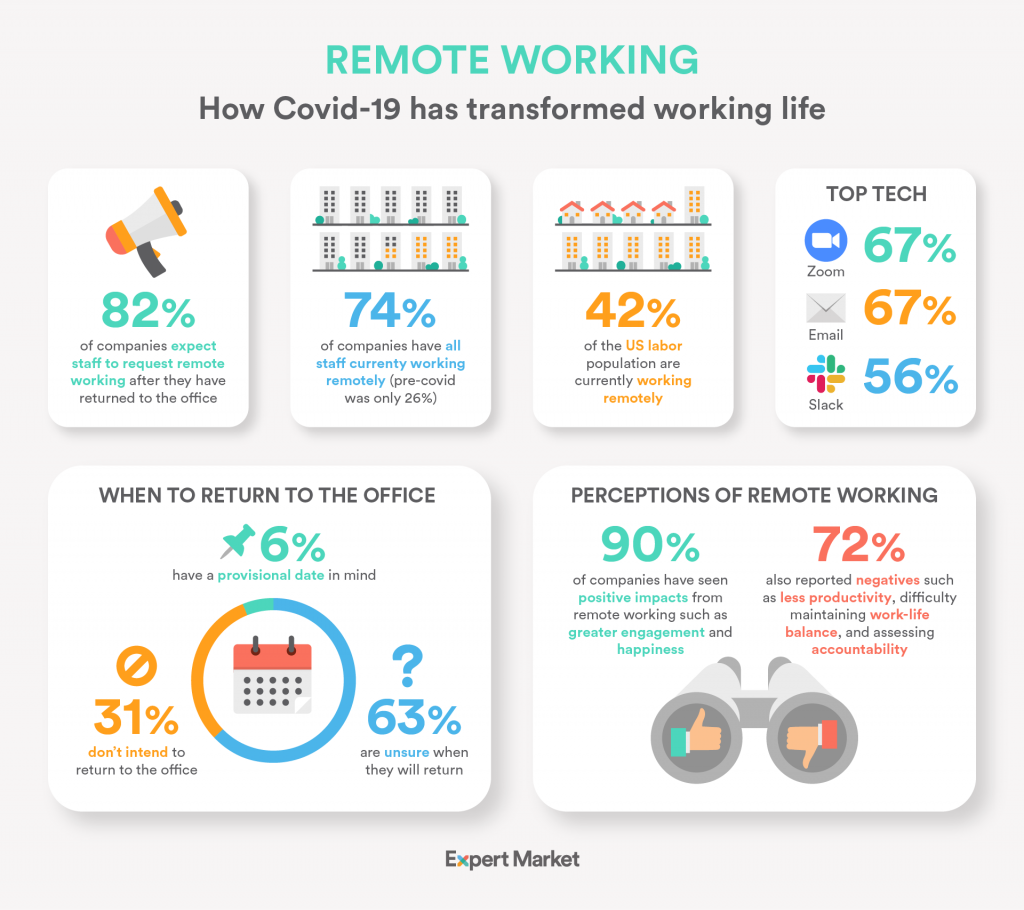Ensuring best workplace communications while remote working
COVID-19 has drastically changed the workplace. We’ve witnessed living rooms turn into offices, and bedrooms become conference rooms. This has greatly affected the way we collaborate and communicate.
In the US, research has shown that 42% of the labor force is working remotely from home. That’s nearly half the working population who have suddenly gone from face-to-face meetings to utilising new technologies like Zoom, Skype, and Slack to communicate with colleagues, clients, and customers.
Homeworking is unlikely to go away, and for some companies, it’s something they’ve taken on permanently. In fact, research has shown that 76% of CEOs are expecting to shrink office space. This brings new exciting opportunities to businesses, but it isn’t without its challenges.
Here are some eye-opening statistics on how companies have found the switch to remote first working:

Remote working research
Business service information site, Expert Market, were interested in how companies have found the switch to remote working, and what their plans for the uncertain future are. They surveyed 100 businesses based in North America and Europe from a range of industries and found:
- 74% of business owners and CEOs said all employees at their company are working remotely
- Before the pandemic, only 7% of participants said the majority of employees were working remotely
- 72% anticipated employees will want to remain working from home, even once the organization returns to the office.
The overwhelming majority of businesses (90%) see positive benefits in working from home including increased employee engagement and happiness, yet at the same time, 71% said they have witnessed negative impacts, such as a reduction in productivity, difficulty maintaining work-life balance, and difficulty assessing accountability.
63% of businesses are unsure when their employees will return to the office, but the most anticipated times for returning were January 2021, Spring 2021, or introducing staggered return times. 67% reported using Zoom and Email to keep in touch with colleagues, followed closely by Slack. Skype, which has seen a fall in popularity over recent years, was only reported by 12.7% of respondents.
The biggest challenges for businesses working remotely were difficulties being creative, assessing accountability, and staying motivated.
Jamie Love from Monumental Marketing commented: “We develop websites and creative assets for our clients. What used to take 10 mins huddled around a table now takes hours over Zoom. We’ve found a nice remedy by setting up a drop-in office in my house where we can come together (when needed and allowed) to increase our productivity”
Similarly, Justin Loncaric of JL Realty Group commented: “In sales, daily check-ins, and weekly pump-up meetings are required. It is difficult to know that everyone is excited, doing work, and keeping up with their responsibilities.”
However, many also reported positives of their new way of working, including connecting with their true motivation, and having a happier workforce due to the greater flexibility.
Alexandra Horwood of Happy Stance Yoga Therapy said: “Remote working has given us more chance to reconnect with our true motivation, why we do what we do, and refresh that initial spark. This pandemic has simply hardened our resolve in realizing that we always need to be on our toes to be at the forefront of our industry. Someone once said to me, If you’re not the lead dog, the view never changes… COVID-19 has proven that to be so true!”
Likewise, Alison Bernstein of Suburban Jungle commented: “Having the optionality to work remotely or in-office is key — and having control over your time and being productive when that works for you is essential in a happy workforce”.
Data on the importance of good workplace communication
Productivity
Research has found that organizations with connected employees show productivity increases or 20-25% and a whopping 97% of workers believe that communication impacts tasks daily. Plus, miscommunication costs companies with over 100 employees an average of $420,000 per year. So it’s crucial to get it right.
Team building
Good communication is vital for collaboration and avoiding a siloed workplace. 86% of corporate executives, educators, and employees cite ineffective communication and poor collaboration as reasons for failures in the workplace.
Giving everyone a voice
From C-suite to Exec level, it’s important employees feel they have a voice in their organisations. In fact, research has shown that those that feel heard in the workplace are five times more likely to feel empowered to deliver great work, and 75% of employers rate teamwork and collaboration as ‘very important’.
4 Remote working communication tips
Frequent catch-ups
Frequent catch-ups are useful in staying up to date with what your colleagues/ employees are working on, which promotes a transparent workforce. This also enables you to more easily assign and delegate tasks and set a time frame for a project without overwhelming your staff.
These meetings also represent a great opportunity to raise any issues, concerns, or roadblocks which can help boost efficiency for that week.
Regular Company Comms Messages
60% of companies don’t have a long-term strategy or vision for their internal comms. This leads to employees feeling undervalued and out of the loop. This is particularly crucial in times of uncertainty such as at the moment. So what should this look like? How should you communicate your message?
A recent survey found that 75% of employees are more likely to watch a video than read a similar message in written form. Weekly or monthly update videos regarding company updates, achievements, new staff and companies news can be more effective than written comms
Using communication tools like Slack where you can have different channels for different parts of the business is also an effective way to share information and encourage sharing and cross-team collaboration.
Using Project Management Software
When asked about the challenges they face due to remote working, one of our survey participants said how important it was to use the right software:
“Communication is pivotal for the success of remote teams, and adopting the right tools and software plays a key role in facilitating this. It is crucial to encourage easy and frequent communication among team members, as well as set up daily conference calls where the team can update each other of their progress and plan for the day.”
Project management tools like Trello, Jira and Basecamp allow your employees to see the progress of projects, while keeping everyone updated with who’s working on what, which helps reduce time spent asking unnecessary questions.
Frequent Check-ins from Managers
Organizing weekly check-ins with your employees gives both parties the chance to discuss any issues that otherwise may be left unsaid or forgotten about. These check-ins may only be a simple chat about the working schedule, but you’ll find that snappy and regular catch-ups will help to build more transparency between line managers and employees, allowing them to air any successes or difficulties in a relaxed setting.
Key takeaways
It has become clear that ensuring your organization is communicating effectively with your employees and clients/ customers is crucial in today’s ever-changing technological world. Those with poor communication typically have less productive employees, lack of confidence in management, and missed deadlines.
It looks like remote work is here to stay, even after the COVID-19 pandemic, so companies need to adapt and make it work. While the COVID-19 pandemic is unpredictable, we can be sure that video conference software such as Zoom, Skype, and Google Meet will remain vital for communication in the workplace, and across the world.
Author Bio
Ella Patenall is a Content Manager for Expert Market, a global resource for business news, product reviews, how-to guides, and all-around inspiration. She writes on SEO, digital marketing, and content marketing. In her spare time, she writes a music blog and plays guitar in an acoustic duo.
How to Use AI-Powered SEO Tools for WordPress eCommerce
SEO is a critical factor in the success of any e-commerce WordPress store. As competition…
0 Comments11 Minutes
Why Short-Form Videos Are the Future of Content Marketing
Your Instagram customers spend over 50% of their time watching short-form videos and reels. Rather…
0 Comments12 Minutes
The Role of Digital Marketing in Business Growth
Online marketing touches every aspect of a business, whether it is initiating the idea or for an…
0 Comments3 Minutes
AI Meets Authenticity: Balancing Automation and Human Touch in Content Marketing
Is your brand starting to sound like a robot? In a world where algorithms write faster than any…
0 Comments8 Minutes
Essential Tools for Enhancing Web Design and UX Hosting
Have you ever visited a website that felt slow, clunky, or confusing? A website that is poorly…
0 Comments11 Minutes
How a Mini Cart Transformed My Store’s Shopping Experience
Okay, real talk—running an online store is hard. You think you’ve got everything figured out, you…
0 Comments9 Minutes
Balancing Your Security Initiatives With Industry Compliance Requirements
Managing a business today comes with a number of daily battles that need to be fought. Resources…
0 Comments11 Minutes
Best plugins to enhance the customer shopping experience
Customer experience is a key part of every online store. A good experience helps customers find…
0 Comments7 Minutes








